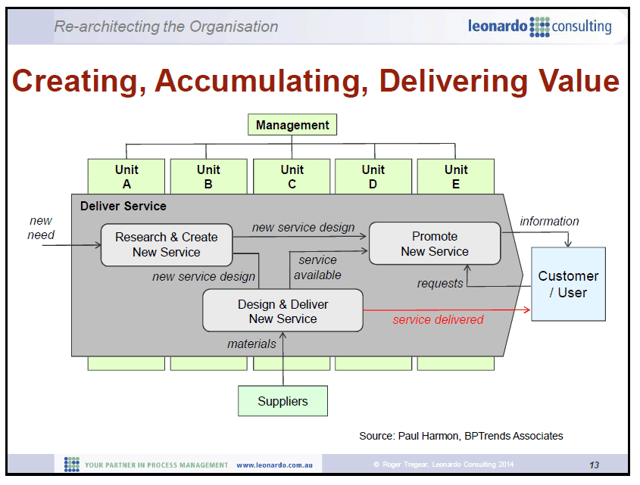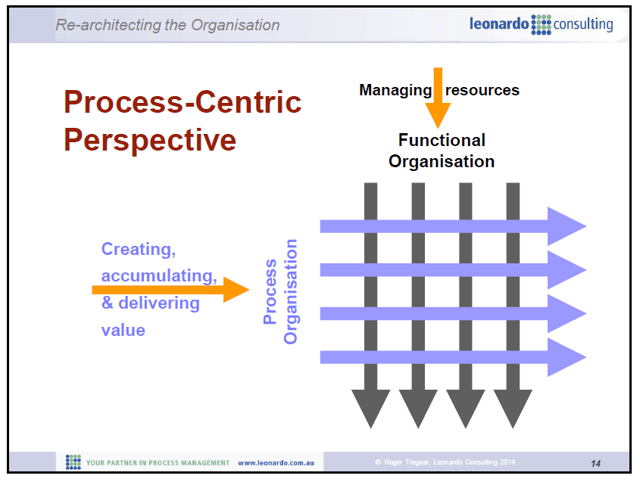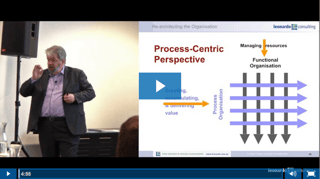The Process Session is a weekly video series posted on The Leonardo Blog that discusses all things BPM and Enterprise Architecture.
Today, Roger talks about 'Designing the Process-Centric Organization'.
Video Transcript -
So - you've got some new product or service. There is some activity that goes toward researching and creating this service. You can then build the service and suppliers get involved. Now we’re ready to go and we can start to promote the service. We can start to have conversations with our customers - they're asking questions and we can provide some information to them.
Any value delivered to the customer yet? None? Not much anyway… We’ve answered a question or two maybe – handed them some brochures but whether we’ve given them some brochures or not is debatable.

It’s at this point here when we can deliver a service that actual value happens. All this other stuff is going to be important but if we don’t design it properly, we can’t deliver value of course. Now obviously we could group ‘Research & Create New Service’, ‘Promote New Service’ and ‘Design and Deliver New Service’ into a higher level process to delivery service.
Nowhere in this architecture have we said anything about the organization or the organization chart…because it is irrelevant. Except that various parts and business units within the organization will combine at various stages to execute the processes. We’re not throwing away the org chart, the various skill groups and geographies that will work together – but the point of the exercise is that we create, accumulate and deliver value to the customer and other stakeholders externally across the organization chart. Rumler and Brache called it, in their famous book ‘managing the white space of the organization chart’. So we create, accumulate and deliver value across the organization chart. The purpose of the various organization units is to contribute to one or more processes.
That’s a very different view of the organization isn’t it? That is the process-centric view. It’s the way it works by the way. Your organizations don’t magically turn into process-centric because of this seminar. It’s the way it’s working now. Or not working now…
Is anyone in your business actually thinking about this cross functional view? It is missing in many organizations.

An even more abstract view of that will have this vertical organization – we’ve got the organizational chart that defines the functional organization (who reports to who, who owns what, where the delegations are is defined and managed). We manage that really closely and really well in this artefact. But we can put an overlay on that – let’s call it the process organization , across and horizontal form and that’s how we are creating, accumulating and delivering value. Both of these things are important. I am certainly not saying you throw out the org chart – I am saying you need to maintain the functional organization but the purpose of the functional organization is to support the process that are happening at right angles to it as it were.
This for me is process-based management on one slide. It’s the message that has got to get through to the ‘C-Suite’, to the senior managers and to the rest of the organization if process based management is to work. What is the compelling reason for process-based management? It is hard to get process-based management to work – to make that transformation is difficult. Once you’re there it becomes embedded and it works but to actually get there – what is the compelling reason? This is missing in many organizations. This is a fundamental issue – most business do the functional well but don’t do the process well.
 Who is in charge of delivering value to your customers and other stakeholders in your organization? Look at your organization and it tells you nothing of that – expect to say that the Chief Executive is in charge. Well – big deal – we knew that. Chief Executives are responsible for everything – it doesn’t help. It certainly doesn’t help them either – it’s a meaningless statement. We’re creating, accumulating and delivering value across the organization and we’re ‘hoping’ we’re doing ok?
Who is in charge of delivering value to your customers and other stakeholders in your organization? Look at your organization and it tells you nothing of that – expect to say that the Chief Executive is in charge. Well – big deal – we knew that. Chief Executives are responsible for everything – it doesn’t help. It certainly doesn’t help them either – it’s a meaningless statement. We’re creating, accumulating and delivering value across the organization and we’re ‘hoping’ we’re doing ok?
That doesn’t sound like much of a strategy.
That is the message that needs to get through to senior management who obviously need to be involved to make these sorts of changes.




